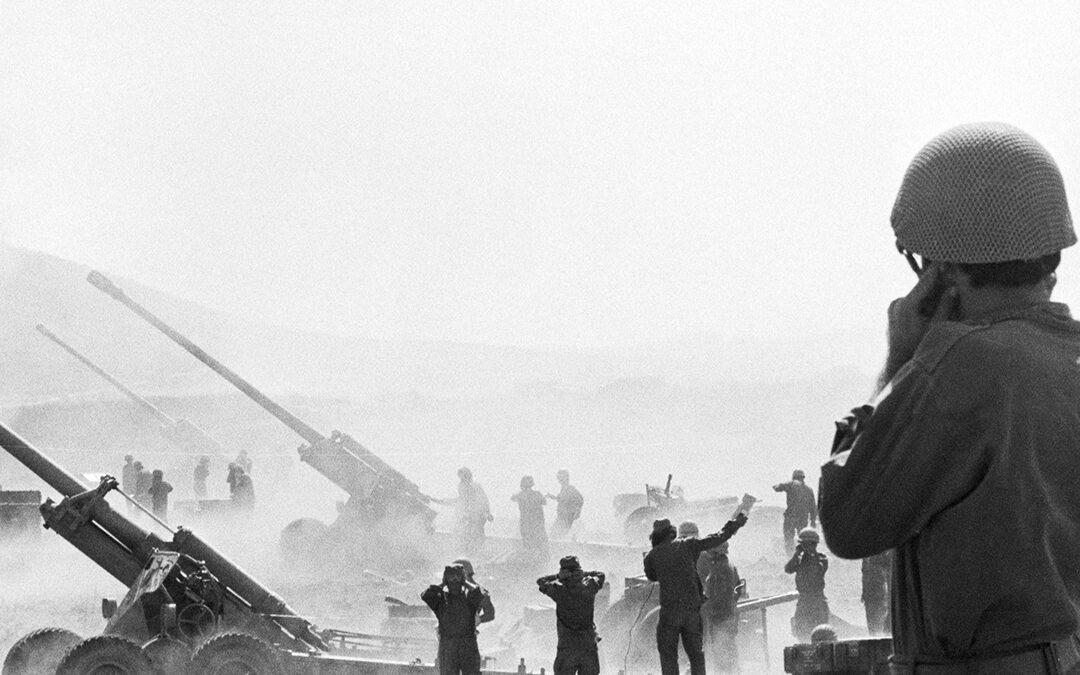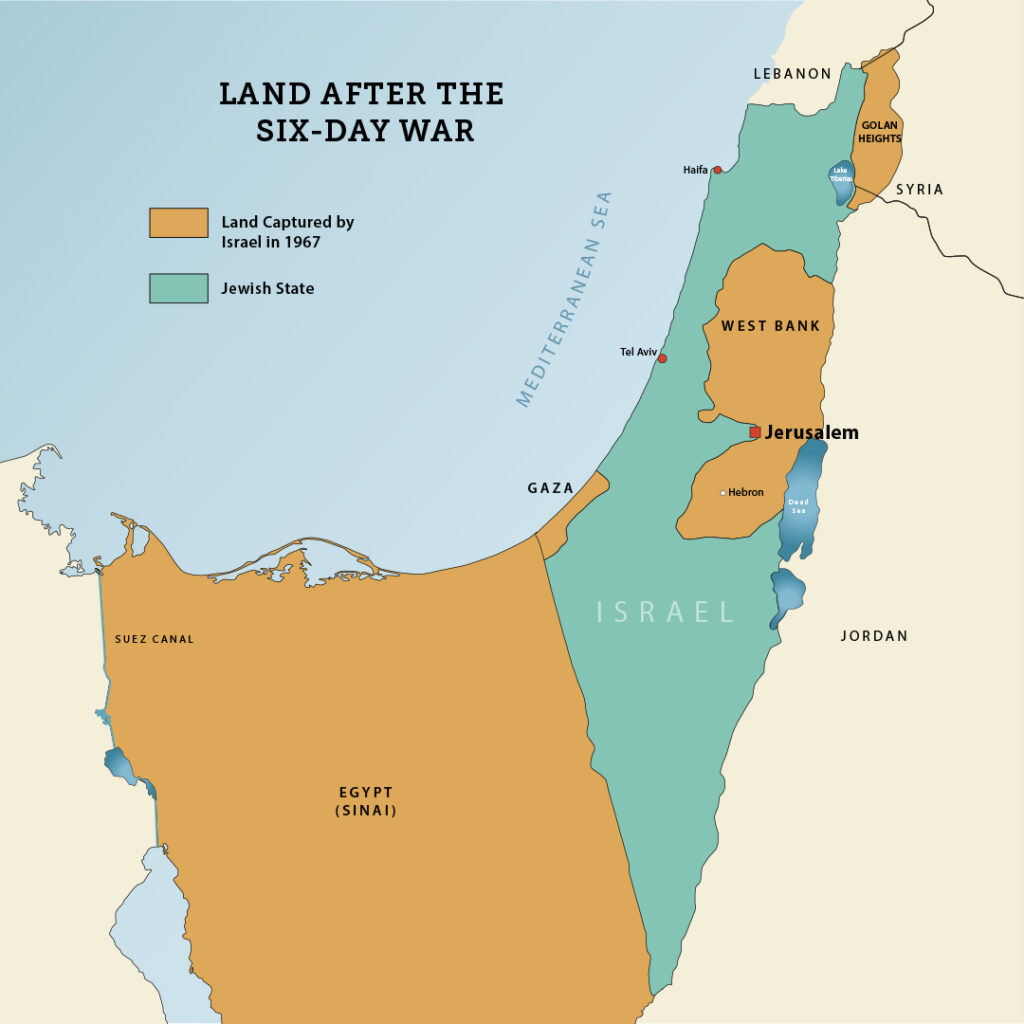THE HISTORY OF ATTEMPTS TO BRING PEACE TO ISRAEL
EDITOR’S NOTE: It is impossible to understand the current situation without first understanding what has come before. Here is the history of Israel and the many peace plans that have been proposed through the decades.
There was no real peace at the conclusion of the war—just a pause in the fighting. For the next two decades, repeated border conflicts, terrorist attacks, and the constant threat of war kept Israel on edge. Another major war would erupt in 1967—the Six-Day War. January, February, and March 1967 were rife with across-the-border bombardment by Syria against the Israelis. April 7, 1967, marked the date when Israel reached the breaking point: IDF tanks rolled into position to return fire against Syrian tanks across the border at the B’not Yaakov Bridge. Israel’s air force strafed several Syrian positions before being challenged by Soviet MiG-21 fighters. Within a matter of minutes, Israeli pilots had shot down six MiGs and chased the remaining fighters to Damascus. One of Israel’s planes was shot down.
In June 1967, determined to stop Israel from crossing the Syrian border in an attempt to end guerrilla raids on Israeli villages, President Nasser sent Egyptian troops to the Israeli border. Although urged by the kings of Saudi Arabia and Jordan to withdraw, Nasser marched inexorably toward war with Israel by requesting that the UN withdraw its emergency force of 3,400 men stationed at Gaza and Sharm el-Sheikh from the Egyptian-Israeli border.
Threatened by this hostile action, Israel took steps to defend her citizens. In a feat of unparalleled planning and execution, Israeli Air Force pilots launched Operation Focus (Mivtza Moked). It was the brainchild of Israel’s Ezer Weizman and was smoothly executed by IAF head, Major General Mordechai Hod. On the morning of June 5th, Israel launched a full-scale attack on Egypt, Jordan, and Syria. In three hours, at least 300 of Egypt’s 430 combat aircraft were destroyed, many still on the ground as the pilots did not have time to take off. Israeli ground forces started a lightning strike into Sinai and by June 8th had reached the Suez Canal. On that day, both sides accepted a UN Security Council call for a cease-fire.
By June 11th, the Arab defeat was total; Israel now held all of historic Palestine, including the Old City of Jerusalem, the West Bank, and the Gaza Strip, as well as Sinai and part of the Golan Heights of Syria. Despite the overwhelming victory, there was still no lasting peace. Just six years later, Israel would face the greatest military threat of her modern existence.
September 13, 1973, was a further catalyst for the Arab world, but it was still not alarming for Israel. On that date, Syrian fighter jets clashed with Israeli aircraft. Thirteen Syrian planes were downed, and only one Israeli Air Force jet was lost. When the Syrians began to amass troops on the Golan Heights, it was thought to be simply saber-rattling in response to the massive air-power loss. This would be a deadly miscalculation for Israel.
At 2:00 PM on October 6, 1973, Yom Kippur, the holiest day of the Jewish year, air raid sirens broke the solemnity of the afternoon. Israel was tragically caught off-guard. Most of the members of its citizen army were in synagogues, its national radio was off the air, and people were enjoying a restful day of reflection and prayer. Therefore, Israel had no immediate response to the coordinated attacks. Israeli intelligence had not seen the assault coming, and her military was ill-prepared to respond.
The Arab coalition had launched the sneak attack against Israel in the hope of finally driving the Jews into the Mediterranean. Shortly after the raucous noise of sirens penetrated the airwaves, Israeli radio broke with tradition and alerted its citizens that the nation was under siege. Egyptian forces were moving across the Suez Canal, and Syrian troops were crossing the Golan Heights. Israel’s 200,000 reserve troops would be faced with a heartstopping number of invading soldiers.
As morning broke on October 7th, Israel’s nearly 300 tanks had been reduced to about 100 in operation. Two more divisions were mobilized, one under the command of Major General Ariel Sharon, the other commanded by Major General Avraham Adan. Minister of Defense Moshe Dayan suggested a retreat to the Mitla and the Gidi passes. He believed these to be more defensible locations. Army Chief of Staff General David Elazar disagreed. He thought a site nearer the canal would provide a better spot from which to launch a counterattack. Even as he and Dayan debated the possibilities, the bloody and deadly battle raged.
As Egypt attacked across the Suez Canal, the battle raged for three days before the Egyptian army established entrenchments, which resulted in an impasse. On the northern border, Syria also launched an offensive.
The initial assault was successful but quickly lost momentum. By the third day of fighting, Israel had lost several thousand soldiers (more Israeli causalities were lost on the first day than in the entire Six-Day War), 49
planes, one-third (more than 500) of her tank force, and a good chunk of the buffer lands gained in the Six-Day War. The Israelis seemed to again be on the brink of a holocaust. On the fourth day of the war, in an act of desperation, the indomitable Prime Minister Golda Meir reportedly opened up three nuclear silos and pointed the missiles toward Egyptian and Syrian military headquarters near Cairo and Damascus. But by the morning of October 10th, after days of fierce fighting, Syria had been pushed back to the line near the Golan Heights from which they had originally launched their offensive.
In the United States at that time, Richard Nixon occupied the Oval Office. Historian Seymour Hersh wrote that earlier in his presidency, “Nixon made it clear he believed warfare was inevitable in the Middle East, a war that could spread and precipitate World War III, with the United States and the Soviet Union squaring off against each other.” The president was now staring down the barrel of that war. He authorized Henry Kissinger to put every American plane that could fly in the air to transport all available conventional arms to Israel. The amount of materiel delivered to defend Israel was more than the supplies airlifted to Berlin following
World War II; it literally turned the tide of the war, saving Israel from extermination and the world from a possible nuclear conflagration. Nixon carried President Kennedy’s agreement to militarily support Israel
to the next logical level—a full military alliance.
The IDF launched a counteroffensive within the week and drove the Syrians to within 25 miles of Damascus. Attempting to aid the Syrians, the Egyptian army went on the offensive, all to no avail. Israeli troops crossed the Suez Canal and encircled the Egyptian Third Army. When the Soviets realized what was happening, they scrambled to further assist Egypt and Syria. The Soviet threat was so real, Nixon feared direct conflict with
the USSR and elevated all military personnel worldwide to DefCon III, meaning forces should prepare for the likelihood of war. However, on October 24th, a cease-fire was finally worked out between the United States
and the USSR, adopted by all parties involved, and the Yom Kippur War had mercifully ended.
We need to raise $250,000 to continue our outreach to the families of victims and the survivors of these attacks. Will you help with your best gift today?
Show Your Support By Giving Now







